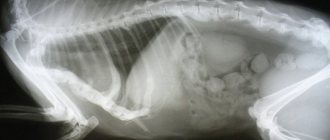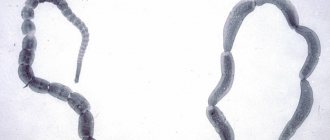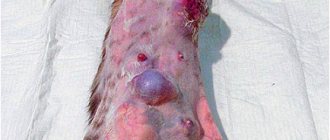Common viral diseases of cats
Viruses cause severe, life-threatening diseases in cats. Infection occurs through air, water, feed, bedding and contact with infected animals. The following factors contribute to the development of the disease:
- Contact with a virus carrier. Visiting cat shows poses a great danger.
- Transmission of viruses through food, water, and air.
- Failure to comply with zoohygienic conditions.
- Stress factors:
- Transportation.
- Bored content.
- Overheating or hypothermia.
- Poor nutrition.
The following diseases are considered the most common and most dangerous among cats:
- Rabies.
- Panleukopenia
- Aueszky's disease.
- Panleukopenia.
- Viral rhinotracheitis.
- Cat flu.
- Calicivirus.
- Coronavirus peritonitis.
- Leukemia.
- Immunodeficiency in cats.
- Herpes.
Virus
Rabies
The most dangerous viral zoonotic disease is rabies. The disease is characterized by the following symptoms:
- The causative agent is myxovirus.
- Carriers are stray dogs, cats, wild carnivores.
- Infection - through saliva from the bite of a sick animal or defects in the skin and mucous membranes.
- Incubation period. After the bite, the animal is observed for 10 days. If no clinical manifestations occur, the animal is considered healthy.
- Symptoms are nervous phenomena.
- Forms of the disease:
- Violent. Excessive drooling, aggressive behavior, perversion of appetite, paralysis. Photophobia, hydrophobia. After 3-11 days the animal dies.
- Paralytic. Lasts up to 4 days. Paralysis occurs without an aggressive phase.
- Atypical. Symptoms erased. Ends in paralysis and death.
- Diagnostics:
- Lifetime - based on anamnesis, epizootic situation, clinical symptoms.
- Post-mortem - histological examination of the brain.
- Treatment. Injection of specific serum within 72 hours. If symptoms appear, treatment is ineffective.
- Prevention - annual vaccination.
Rabies in a cat
Clinical symptoms of viral infection
Each infectious disease in cats has its own individual symptoms. There are a number of characteristics that will allow you to timely detect the initial stage of almost any of them: a change in behavior. Most often this is lethargy, a depressed state. In some cases, a sick animal may become overly persistent in seeking communication.
Some cat diseases are characterized by an aggressive attitude towards others. It must be taken into account that the cat’s search for a secluded place may be the beginning of developing photophobia; abnormal discharge is observed, and not only from the eyes. This is increased salivation, various forms of vomiting (with blood, mucus), diarrhea, constipation; changes in mucous membranes and skin.
Lethargy and inactivity are signs of cat illness
Various erosions, ulcers, blisters, focal dermatitis and other things may appear; temperature increase. Since most infectious diseases of cats are accompanied by an inflammatory process, any change on the thermometer should be a reason to contact a veterinary clinic. Of course, the list is far from complete, but any of the indicators described should alert the owner.
Aueszky's disease
Cats are the first to get sick; productive animals become infected from them. A person becomes infected through meat. The disease is characterized by the following symptoms:
- The causative agent is herpesvirus.
- Carriers are rodents, infected pigs.
- Infection occurs through eating virus-carrying mice, rats and contact with pigs.
- Incubation period. Up to eight days.
- Symptoms are nervous phenomena.
- Forms of the disease:
- Classic. Excitement gives way to depression. Constant meowing, drooling, vomiting, photophobia, itching, death.
- Atypical. Severe depression, the animal does not meow. Quick death.
- Encephalitic. Signs similar to the classical form. Additionally - aggressiveness, lack of coordination, paralysis.
- Gastroenteritis. Severe pain in the abdominal cavity, vomiting, sudden death.
- Diagnostics. It is necessary to distinguish between Aueszky's disease (pseudorabies) and rabies.
- Treatment. In the initial phase use:
- Immunoglobulin Vitafel.
- Immunostimulants - phosphoprenyl, immunofan, gamavit.
- Antibiotics - maxidin.
- Prevention has not been developed.
International Veterinary Center for Reproduction and Artificial Insemination of Small Animals
Dear cat owners, check your pets
for immunodeficiency (“feline AIDS”), leukemia (leukemia) and infectious peritonitis.
In our center, you now have the opportunity to test your pet for these deadly infections using a highly specific express method.
CAT IMMUNODEFICIENCY FIV (“feline AIDS”)
Feline immunodeficiency virus (FIV), a member of the retrovirus family, is very similar to human immunodeficiency virus (HIV), having a similar structure. The virus is common in domestic cat populations around the world. Cats of all ages can become infected; the most common route of infection is through saliva (bites) during fights. Transmission of the virus from mother to offspring is possible. Although sexual transmission through natural infection has not been recorded, a cat can be infected by a cat biting it during mating. Infection through surrounding objects and by airborne droplets is unlikely.
- Clinical signs:
8 – 12 weeks after infection the following symptoms may appear: lack of appetite, depression, fever. This condition quickly passes, and the disease enters the so-called “asymptomatic” phase, which can last for many years or even a lifetime. The duration of the “asymptomatic” phase can vary significantly. Based on experimental studies, it has been established that cats infected at a young age are more likely to develop a state of immunodeficiency. However, many infected cats eventually develop functional immunodeficiency, clinical signs of AIDS, and death. Typically, clinical manifestations occur between the ages of 4 and 6 years and manifest themselves in the form of chronic gingivitis and stomatitis, chronic rhinitis, pathologies of the lymphatic system and kidneys, and weight loss. There are also concomitant viral, bacterial, fungal and protozoal infections. Unusually severe parasitic skin diseases (demodex, pediculosis) or neoplasms also occur. Lymphosarcoma and squamous cell carcinoma can also occur due to FIV infection.
- Treatment:
General care: isolation from other cats, sterilization and regular medical examinations. The treatment is experimental and its effectiveness has not yet been proven.
FELVINE LEUKEMIA FeLV (leukemia)
Feline leukemia virus (leukemia) is a retrovirus that can cause a weakened immune system, anemia and lymphosarcoma. Young kittens are especially susceptible to infection; with age, susceptibility to infection decreases. Transmission of the infection occurs when the virus is released through saliva, feces, nasal secretions, and milk by infected cats. Transmission of the virus from cat to cat occurs through mutual contact (courtship), as well as through bites.
- Clinical signs:
The most common features are anemia, immune suppression (susceptibility to other infections), and lymphosarcoma (thymus, digestive, multiple or atypical). Less common signs: kidney damage (glomerulonephritis), polyarthritis; chronic enteritis; reproductive dysfunction (fetal resorption, abortion, neonatal death and the birth of “fading” kittens). Typical ocular lesions are inflammation and tumors of the choroid, damage to the retina, and the possible formation of secondary cataracts. Neurological disorders are also noted (nystagmus, Horner's syndrome, paralysis, etc.).
- Treatment:
Supportive and symptomatic therapy, treatment of secondary infections. The prognosis is bad. Cats with a severe form of the disease die within 2 to 3 years.
FINE INFECTIOUS PERITONITIS (FIP)
Coronavirus infection is extremely common in domestic cats. Coronavirus can survive for 7 weeks in dry conditions and can easily be transmitted indirectly, for example through shipping containers, clothing, hands, shoes. In some catteries and shelters, the number of infected cats can vary from 90 to 100%. In nurseries, kittens are usually infected at an early age, before they are weaned from their mother. Wild felines can also be carriers of this disease. Feces are the main source of coronavirus infection. Trays and carriers for cats are the main source of infection when cats are kept in groups. Contamination through saliva can occur through direct contact or eating from the same bowl. Susceptible cats are most likely to become infected from asymptomatic cats. A significant proportion of cats infected with coronavirus develop infectious peritonitis, a fatal disease. Among some cat breeds, certain lines are more predisposed to FIP. Age is one of the important risk factors; in 70% of cats, the disease manifests itself before the age of 1 year. However, this disease has been diagnosed in cats before 17 years of age.
- Clinical signs:
Most cats infected with coronavirus are asymptomatic or show mild signs of enteritis. Some cats (12%) develop FIP (infectious peritonitis). FIP exists in two main forms: exudative (“wet”) and non-exudative (“dry”). The exudative form is characterized by inflammation of the serous membranes of the chest and abdominal cavities due to damage to the walls of blood vessels. Non-exudative form, characterized by multiple lesions of internal organs. Most cats have clinical signs of both forms of the disease: fever (high temperature), lethargy, anorexia and weight loss; accumulation of fluid in the abdominal, thoracic and pericardial cavities. Eye lesions that often occur include changes in the color of the iris, changes in the shape or size of the pupils, sudden loss of vision, or a buildup of blood or fibrin in the anterior chamber of the eye (due to inflammation of the uvea). Neurological lesions also occur.
- Treatment:
Once a diagnosis of FIP is confirmed, the prognosis for most cats is poor (fatal). Factors indicating a short life span (up to 10 days) are a low lymphocyte count, high bilirubin levels and the presence of a significant amount of exudate. Effective treatment methods have not been developed to date. If there is no positive effect from treatment within 3 days, success is unlikely, treatment should be considered ineffective and euthanasia should be considered.
| Menshenina Elena Surenovna veterinarian, chief reproductive specialist e-mail: petclon [at] rambler [dot] ru 2013 The authorship of this article is protected by the Copyright Law. Any copying of materials without indicating the author and a link to the original source “International Veterinary Center for Reproduction and Artificial Insemination of Small Animals” is prohibited |
Similar materials
- CATARACTS IN CATS. DIAGNOSIS AND TREATMENT.
- Small intestinal foreign body in a cat
- Reproductive problems in cats
- Calendar of expected births in cats.
- Life before birth: cats.
Panleukopenia
Feline distemper (panleukopenia) is the most dangerous disease with a high mortality rate. Survivors of a four-day illness become virus carriers. In the warmer months, young animals and old cats get sick. The pathology is characterized by the following symptoms:
- The causative agent is parvovirus.
- Carriers are sick and recovered cats, blood-sucking insects.
- Infection is through the air, flea bites, and cat feces. Intrauterine infection.
- The incubation period is 2...10 days.
- Symptoms:
- Vomit. Yellow-green mucous discharge with blood. Foul bloody diarrhea.
- Starvation.
- Cardiovascular failure.
- Body temperature >41°C.
- Conjunctivitis, rhinitis. Dry mucous membranes. Dehydration of the body.
- Coma. Sudden death.
- Diagnosis - clinic and epizootic situation. A blood test shows a drop in the number of leukocytes to 3*103/ml when the norm is 5.5...18.5*103. It is necessary to distinguish panleukopenia from non-contagious enteritis and toxoplasma invasion.
- Treatment is symptomatic. Administration of drugs is parenteral. The tablets cause a gag reflex. Apply:
- Subcutaneous injections of saline to relieve symptoms of dehydration.
- Hemostatic drugs.
- Vitamins of category B, to replenish spent reserves.
- Antibiotics to suppress secondary microflora.
- Diet food. The appearance of appetite is a favorable sign. Rehabilitation nutrition is as follows:
- Limiting carbohydrates at the expense of proteins.
- The first days - kefir and white bread soaked in low-fat meat broth.
- On the third day - specialized ready-made gentle food.
- A four-week ban on raw foods and vegetables is imposed.
Animals that have recovered from the disease acquire stable immunity to parvovirus. Antibodies protect offspring up to twelve weeks of age.
- Prevention - vaccination.
Viral rhinotracheitis
The disease affects the organs of vision and breathing. The mortality rate does not exceed 20% of the number of cases. Those who have recovered from the disease develop lifelong immunity. The pathology is characterized by the following symptoms: The causative agent is the herpes virus.
- Carriers are sick and recovered cats.
- Infection - air, discharge from the genitals, eyes, nose. Infection is transmitted through food, contact between people and insects.
- The incubation period is 3...8 days.
- Symptoms:
- Acute form:
- Inflammation of the conjunctiva. Rhinitis.
- Cough.
- Ulcers on the tongue.
- Hyperemia of the mucous membranes. Redness of the nose.
- Temperature >40°C.
The acute form ends with recovery after a decade.
- Chronic form:
- Constipation.
- Chronic rhinitis lasts for years.
- Bronchitis develops, developing into pneumonia
- Ulcers appear on the skin.
- The nervous system is affected.
- Abortions and stillbirths are recorded.
- Diagnosis: clinic, tests of nasal and eye secretions.
- Treatment is symptomatic. Apply:
- Universal antibiotics.
- Sulfonamides.
- Antihistamines.
- B vitamins. Ascorbic acid.
- Dietary nutrition consists of the use of liquid boiled feed.
- Prevention - vaccination.
Calicivirus
Calicivirus
The disease affects the respiratory system. They get sick during the cold months. The disease is characterized by the following symptoms:
- The causative agent is calicivirus.
- Carriers are sick cats, virus carriers.
- Infection is through the air and by contact.
- The incubation period is 1...3 days.
- Symptoms resemble those of rhinotracheitis. Calicivirus is complicated by stomatitis, diseases of vision and breathing. The disease lasts 7...21 days. Mortality - 30%.
- Diagnosis - clinic, epizootic situation, blood tests. Anemia and leukopenia are observed.
- Treatment is symptomatic. Apply:
- Universal antibiotics.
- Sulfonamides.
- Nitrofurans.
- Vitamins A, C, B12.
- Hyperimmune serum.
- Dietary nutrition, as for leukopenia.
- Prevention - vaccination.
Calicivirus
Giardiasis in cats
This is the name of a protozoal infection caused by parasitic protozoa, Giardia. Presumably, the prevalence of the disease is extremely high; some experts believe that up to 70-80% of all domestic cats (and dogs, by the way, too) can be carriers.
The disease is very interesting, since many aspects of the life activity of the parasite have not yet been properly studied. In particular, infectious disease specialists have not yet come to a common conclusion regarding whether Giardia that can be transmitted to humans exists. So far, it is believed that this is impossible, but when caring for a sick pet, you should strictly follow the rules of personal hygiene.
In most cases, giardiasis is asymptomatic. But this applies more to adult cats. Young animals usually develop severe, debilitating diarrhea. Most often, the appetite of sick animals does not change, but the pets still begin to chronically lose weight.
Feces acquire a whitish-faded color and a disgusting odor, the consistency of feces often becomes greasy (the ulcerated intestine cannot digest and absorb lipids). Accordingly, sick cats quickly develop exhaustion, dehydration, and their skin and coat condition worsens.
There is a treatment for giardiasis for cats, it is actively used, but none of the therapeutic methods has yet been approved by the International Veterinary Association. In particular, Fenbendazole is very effective. As a rule, it is used to eliminate helminthic infestations, but it is also forced to be used in the treatment of cats for giardiasis.
Can be given to animals in combination with metronidazole. The latter is the key to the absence of secondary bacterial infections. The combination of these drugs helps to cope with microscopic parasites in more than 70% of cases. Unfortunately, the method has many drawbacks (which is why they are in no hurry to officially approve it). In particular, in some cats, such therapy can cause vomiting, anorexia and even neurological seizures. In addition, metronidazole is bad for the liver of pets, and therefore choosing a safe dose can be difficult. Finally, it can also cause kidney damage.
Coronavirus peritonitis
Presents a problem for fellinologists running a nursery. Among the many relatively harmless coronaviruses is a deadly one. The disease is difficult to diagnose. It resembles diseases of the brain, eyes, digestive organs and cardiovascular pathologies. Young animals up to two years old and old cats are affected. Mortality is high. The disease is characterized by the following symptoms:
- The causative agent is the FIP coronavirus.
- Carriers are sick and recovered cats.
- Infection - through the air, discharge from the genitals, nose, eyes. Infection is transmitted through food, contact between people and insects.
- The incubation period is 21 days.
- Symptoms:
- Temperature >40°C.
- Symptoms of peritonitis.
- Vomit.
- Ascites.
- The stomach is swollen.
- Treatment is symptomatic. Universal antibiotics are used to destroy the accompanying microflora.
- Prevention. Not developed.
Coronavirus peritonitis
Leukemia virus
Destroys the immune system, causes the development of cancer. The disease is characterized by the following symptoms:
- The causative agent is FeLV.
- Carriers are sick and recovered cats.
- Infection is contact.
- Symptoms:
- Exhaustion.
- Heat.
- Starvation.
- Lethargy.
- Anemia.
- Dermatitis.
- Poor wound healing.
- Forms of the disease. There are three options for the development of events, with an equal degree of probability:
- The immune system produces antibodies, and the cat recovers.
- Asymptomatic virus carriers. A cat is dangerous to other animals. After a long time, the symptoms described above develop, and the animal dies painfully.
- The cancer progresses quickly.
- Diagnostics. Analysis for FeLV. If the result is positive, it is repeated after three months
- Treatment is symptomatic.
- Prevention. Vaccination. Isolation from other infected cats.
Leukemia virus
Prevention of infectious diseases
To reduce the risk of feline viral diseases occurring, the following must be ensured:
- the cat must have a healthy and balanced diet;
- it is necessary to treat animals for parasites, not only external, but also internal;
- regularly carry out vaccinations in a veterinary clinic (using the drugs leukotsel, quadricate, purevax, nobivac, multifel, felovax).
If sick animals are found, it is necessary to isolate them so that viral diseases of cats are not transmitted to others.
An examination by a veterinarian is an important step towards your pet’s recovery. It is impossible to diagnose a viral disease on your own, and if treated incorrectly, your pet may die. It is important to immediately contact a veterinarian to find out the diagnosis and receive treatment recommendations.
Feline immunodeficiency
This is the feline version of human HIV. The disease is characterized by the following symptoms:
- The causative agent is the FIV virus.
- Carriers are sick and recovered cats.
- Infection is contact.
- The incubation period is long.
- Symptoms:
- Exhaustion.
- Heat.
- Refusal of food.
- Lethargy.
- Anemia.
- Diarrhea.
- Encephalopathy.
- Leukopenia.
- Stomatitis, glossitis, gingivitis.
- Udder tumor.
- Rhinitis, conjunctivitis.
- Pyoderma.
- Dermatitis.
- Wounds do not heal well.
- Diagnostics. Serological tests for FIV.
- Prevention. Isolation from sick cats.
Feline immunodeficiency
Treatment
Treatment of viral diseases in cats is always quite difficult and not always effective. Modern medicine, however, has recently made great progress in this direction; veterinarians have a sufficient number of serums in their arsenal that can help a pet if the disease is detected in the initial stages.
© shutterstock
The main goals of therapy for viral and infectious problems in cats are:
- viral suppression
- restoration of protective barriers of mucous membranes,
- prevention of secondary infection.
In addition to therapeutic actions, it is necessary to adhere to a diet and administer vitamin supplements when feeding a sick cat. This will help rid her body of toxins that accumulate during the course of the disease.
It is important to recognize and treat diseases as early as possible. Specific globulins and serums are effective in combating diseases in cats caused by viruses, and immunostimulants have proven themselves. It is noted that in advanced forms, when they turned for help quite late, they are useless.
It is important to know that each case requires individual treatment, which can only be correctly selected and prescribed by a veterinarian, based on the clinical picture of the disease and tests.
If the owner decides to treat the cat himself, he must think about the possible consequences. Most often they lead to dangerous complications and death of the pet.
The duration of the disease can be long with multiple diagnostics, tests, medications, but the tactics prescribed by the doctor must be strictly followed.
Herpes
The disease is characterized by the following symptoms:
- The causative agent is the herpes virus.
- Transmitted intraplacentally.
- The incubation period is 3 days.
- Symptoms:
- Depression.
- Purulent conjunctivitis.
- Keratitis.
- Yellow-green diarrhea.
- Ulcerative stomatitis.
- Pneumonia.
- Stillbirth.
- Treatment is symptomatic.
- Prevention - vaccination.
We invite you to join our Zen channel and group on VKontakte or Odnoklassniki, where new articles for pet owners are published.
Similar articles:
- If your cat has food allergies
- Ringworm Caution: What Pet Owners Need to Know
- Why are cats overweight?










